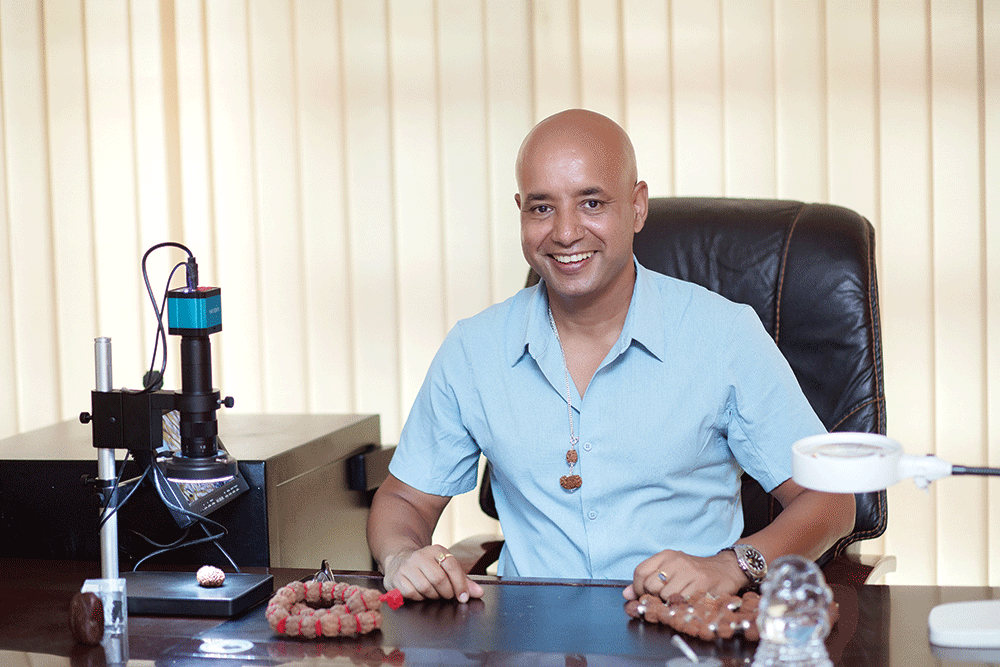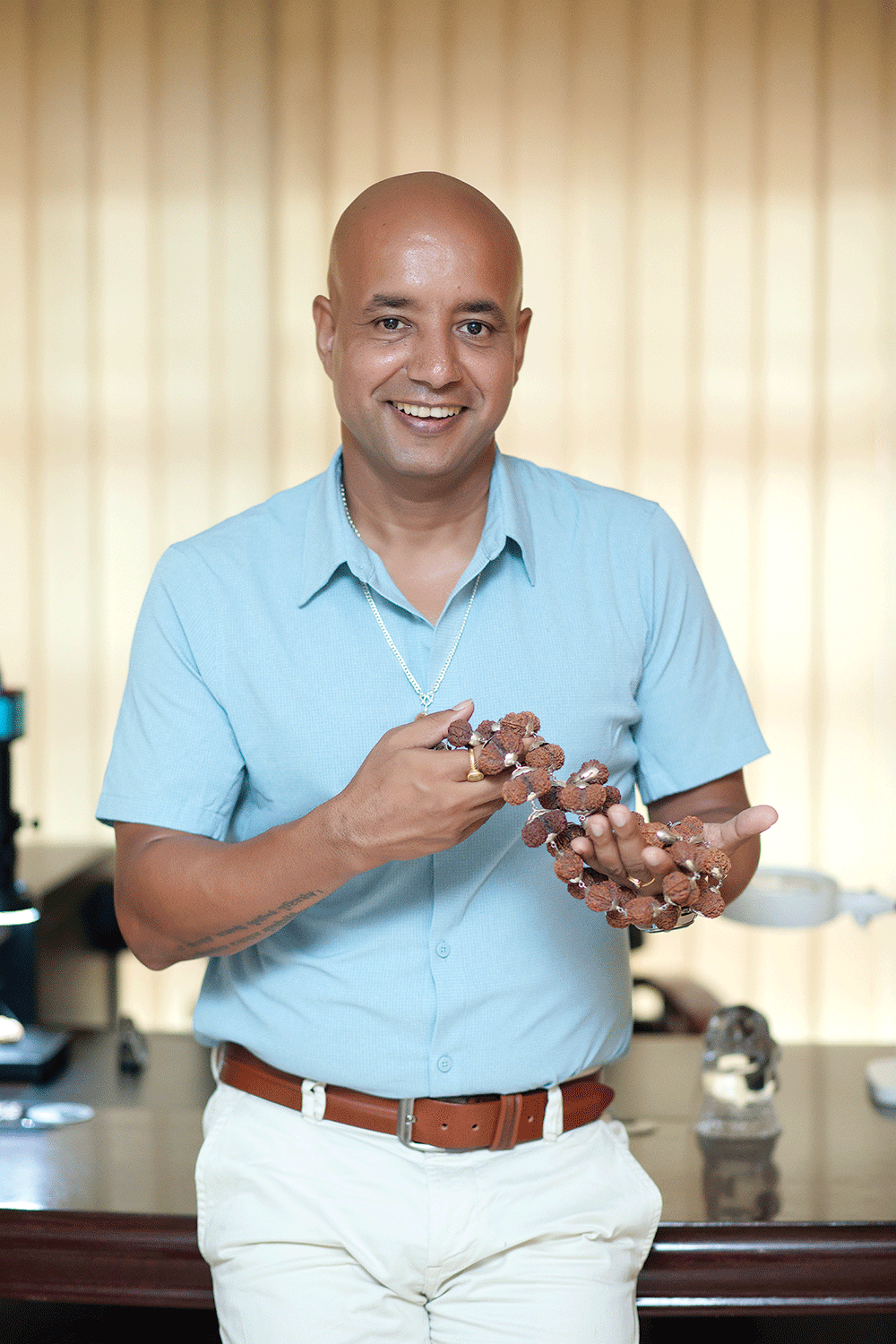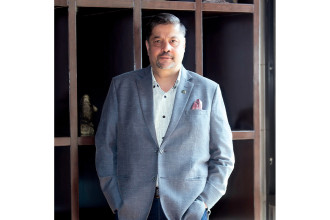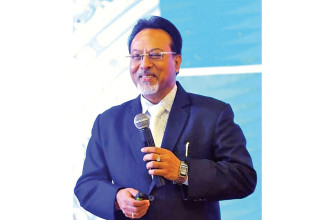
Mukunda Khatiwada
Proprietor, Nepa Rudraksha
The only ISO 9001:2015 certified venture selling rudrakshas in Nepal, Nepa Rudraksha has been in business since 1959. Mukunda Khatiwada, Proprietor of Nepa Rudraksha, mentions that initially his father had set up shop in the Pashupati area and there were only four such shops in the area during that time. The rudraksha business, he says, has been growing steadily in Nepal with buyers coming from not only within the country but across the world. While still working with his father, Khatiwada shares he completed his MBA and then he was in a dilemma as to whether to continue with the family business or start something different on his own. After much contemplation, he decided to get involved in the rudraksha business and thought of ways on how he could expand the family trade. In 1999, Khatiwada took the store online and since then he mentions he has seen more growth. “I am proud to mention that all the big rudraksha dealers across the world recognise us by our name itself, for both wholesale and retail trade,” Khatiwada states, adding that at present more than wholesale he has been focusing on the online business. Not wanting to limit his business to Nepal alone, he shares, he opened a branch in the United States about two years back and gradually sales have been picking up. In this issue of Business 360, we spoke to Khatiwada about the significance of rudraksha and how its business has been doing in the country.Could you please elaborate on the significance of rudraksha? What exactly does it entail?
As per our religious scriptures, when Lord Shiva set out to burn down Tripurasur it was a pretty difficult task for him. When he was finally able to do so he burst out into laughter and the tears of joy that fell on the mountain “Shail Parbat” transformed into trees bearing the rudraksha. On seeing the trees Goddess Parvati questioned Shiva on their necessity and he replied that it was for the benefit of humankind, something that has been born out of his happiness. So, it is believed that the rudraksha is like a blessing and these days not only Hindus but people belonging to other religions too wear rudrakshas. In fact, there is an entire Upanishad called the “Rudrakshajabalopanishad” on rudraksha and its significance. It is also mentioned in the Devi Bhagvata and Shiva Purana. The Vidyeshwara Samhita in the Shiva Purana contains 80 sets of conversations between Lord Shiva and Goddess Parvati where everything is explained in detail about the rudraksha. In the ancient times one could find rudrakshas that were one-mukhi (face) till 38-face. However, at present we get rudrakshas up to 29 faces only.What spiritual or religious significance does a rudraksha have? How does it benefit the person wearing it?
When Adi Shankaracharya, an Indian Vedic scholar and teacher, was travelling and preaching about Hinduism, he arrived in Nepal and learnt about the significance of the rudraksha. He started the tradition of using a garland (mala) with 33 beads of similar-sized and type of Nepali rudrakshas during prayers and meditation. This type of mala is called kantha mala which are of a bigger size than the normal Nepali rudraksha. Even today the main priests of Lord Pashupatinath Temple use this during prayers at the temple. Without wearing that necklet the prayers are considered incomplete. These days, normal persons, astrologers and religious practitioners use different types of rudraksha/rudraksha combination and mala for meditation and some as a way to fulfil their desires. Many use rudraksha to get rid of negativity at home. There are many people who wear rudraksha combination for specific reasons. For example, experts and astrologers after obtaining the time and date of birth of a person study planet (graha) position and recommend suitable rudraksha combination or mala based on religious scriptures. For instance, if a five-face rudraksha necklet is for religious chants, then you have the siddha mala which contains rudrakshas of one-mukhi Savar to 14-mukhi Gaurishankar and Ganesha. Those necklets with rudrakshas of Savar till 16 mukhi are called Sarvasiddha mala, and those with one-face till 19 mukhi are called Gayatri Siddha mala. So there are different types of necklets based on different rudrakshas. The rudrakshas that I am talking about are Nepali ones. The Indonesian rudrakshas are very small. Nepali rudrakshas are a bit bigger and considered to be more beautiful and powerful and are also very rare hence more in demand and their prices are also high. Nowadays some spiritual gurus are using rudrakshas for science therapy too. Therapy in the sense that even our grandfathers used to follow a practice of keeping some rudrakshas in a jar of water overnight and drinking the water the following morning. And then there is a belief that one has to wear specific rudrakshas for specific purposes.
Besides Nepal where can we find rudraksha trees?
Rudrakshas are actually found mainly in Nepal, but we also find them in Indonesia and India. Indonesian rudrakshas are small in size so mostly all malas (small size of 108 beads) are Indonesian rudrakshas. Both Nepali and Indonesian rudrakshas have a natural hole, and the Indian rudrakshas which do not have a natural hole are of a different genus. The ones in Nepal and Indonesia are of Elaeocarpus ganitrus genus but the ones found in India are Elaeocarpus ganitrus Roxb. Rudrakshas in Nepal have multi-seed and compartments. The rudraksha trees are mostly found in Bhojpur and Sankhuwasabha districts of Nepal. But at present we can find trees in different regions of the tarai too. The rudraksha tree grows well in the Arun valley region.There is rumour of an influx of fake rudrakshas coming from China. How can we differentiate an original from a fake?
It is just a rumour and there is no fake rudraksha coming from China. In fact, China has become a major importer of rudrakshas for a couple of years. Nepali rudrakshas are getting more popular in China nowadays. To overcome this dilemma, the first thing a buyer needs to keep in mind is to buy from a reliable source. You can also differentiate an original rudraksha from a fake by its colour because an original rudraksha’s colour changes once you start wearing it. When you first buy a rudraksha it is cream in colour and as you wear it, it becomes darker. If some part has been manipulated, then that part does not change its colour. The colour of an artificial rudraksha does not change.What determines the price of a rudraksha?
The price of a rudraksha is mainly determined as per its availability. Those that are rare to find are more expensive. The four-face, five-face and six-face rudrakshas are available in plenty in Nepal. You can actually buy them in kilos. Then those that are seven-face and above are sold on per unit basis because it is difficult to find them. The line on the bead which starts from top to bottom is called mukhi (face). When the availability is low its demand rises and subsequently the price too. Rudrakshas above 14 mukhi are limited so higher the mukhi the more difficult it is to find them thus they are more expensive. The most expensive is 21 mukhi.How has the market for rudrakshas developed over the years?
Unlike in the past, these days there are scores of shops selling rudrakshas in the Pashupati area. Even in Haridwar, Varanasi and various Shiva temples across India there is a huge market for it. In fact, if you look up on the internet you will find hundreds of sites selling rudrakshas. So the market for rudrakshas has been growing quite substantially. Around 2014, the Chinese too entered this market and they buy a lot of rudrakshas from Nepal. They also go to Indonesia and buy whole trees. However, the Chinese are more attracted towards the flat and similar types of rudrakshas of same mukhi specially up to 14 mukhi. During one of my visits to China, I found that Chinese people love playing with rudrakshas and enjoy it as a type of therapy. They wear a bracelet with 13 rudrakshas and keep rotating it and when the rudrakshas become shinier and darker they consider it better. Before the pandemic the Chinese market was good. For two years the market in China has shrunk otherwise there would be thousands of Chinese vendors in Khandbari area. In comparison, I feel we Nepalis do not use rudrakshas so much. The main market for rudrakshas is India, especially for religious purposes. If you look at the market at the moment you will notice that more than us, it is the Chinese who are buying and using rudraksha. Even though the market has seen positive growth, buyers must be wary of new sellers who might provide lower quality rudraksha or might recommend based on what’s available in their inventory rather than what the end user actually needs.Are there any conditions or obligations that need to be fulfilled while wearing a rudraksha?
As I have mentioned earlier about how Lord Shiva explained to Parvati that he had created the rudraksha for the benefit of humankind, so any person can wear it. As per tradition, anybody from the age of five can wear it. There is no restriction actually. As per the Hindu culture, we usually follow either Krishna Yajurveda or Shukla Yajurveda. For example, in South India, most people follow Krishna Yajurveda and we Nepalis and North Indians mostly follow Shukla Yajurveda. Therefore the restrictions would depend on the individual’s culture and their personal beliefs. But these restrictions or guidelines are not to demotivate people from wearing a rudraksha but are rather intended for them to get most out of wearing one. There is a belief that it takes 42 days for a rudraksha to interact with the wearer. Personally, I would advise people to take off their rudraksha before going to bed and wear it after taking a bath the next morning. I would also strongly recommend practising mantra chanting along with wearing rudraksha to get the most holistic benefit. Every type of rudraksha has its own significance. The one-face rudraksha is the rarest and any person who has even the slightest knowledge of rudrakshas wants to own one. The ones that come from Rameshwaram (South India) are shaped like a cashew nut and those from Indonesia are very small, slightly bigger than a rice grain. The Nepali one-face rudraksha, which is in Pashupatinath, is very rare and when you wear that there is a belief that it provides spiritual guidance and leads towards Moksha. The two-face rudraksha is considered half Shiva and half Parvati and that is supposed to make the bond between the spouses stronger. Similarly, the three-face one is called Brahma, Vishnu and Mahesh. The four-face rudraksha is considered to be Brahma and five-face is considered to be Shiva. The six-face rudraksha represents Kumar and it is worn for wisdom and South Indians use this a lot. The Chinese also mostly buy six-face rudrakshas. For educational purposes, there is a belief that the three-face rudraksha is best. When two rudrakshas are conjoined it is called Gaurishankar and when three are conjoined it is called Trijuti rudraksha which is considered as Brahma, Vishnu and Shiva. Two rudrakshas conjoined with only one face on either side is called Savar. Gaurishankar is common so it is not very expensive but the Trijuti is very rare and costly. The 14 mukhi rudraksha is the most sought after because it is considered auspicious for business. It also represents Hanuman. So every rudraksha has a significance and a name. The 21 mukhi rudraksha is considered to be Kuber, which is also very rare, only one or two grow a year in Nepal. Anyone who wants to wear a rudraksha can wear mala, bracelet or a few beads as necklace of diffrent mukhi, if somebody wants to chant a certain mantra, the small five mukhi rudrakshas of Indonesian variety, if someone wants to wear a Nepali rudraksha mala or combination then it is better to consult an astrologer or rudraksha expert before doing so. READ ALSO:
Published Date: November 10, 2022, 12:00 am
Post Comment
E-Magazine
RELATED Face 2 Face





